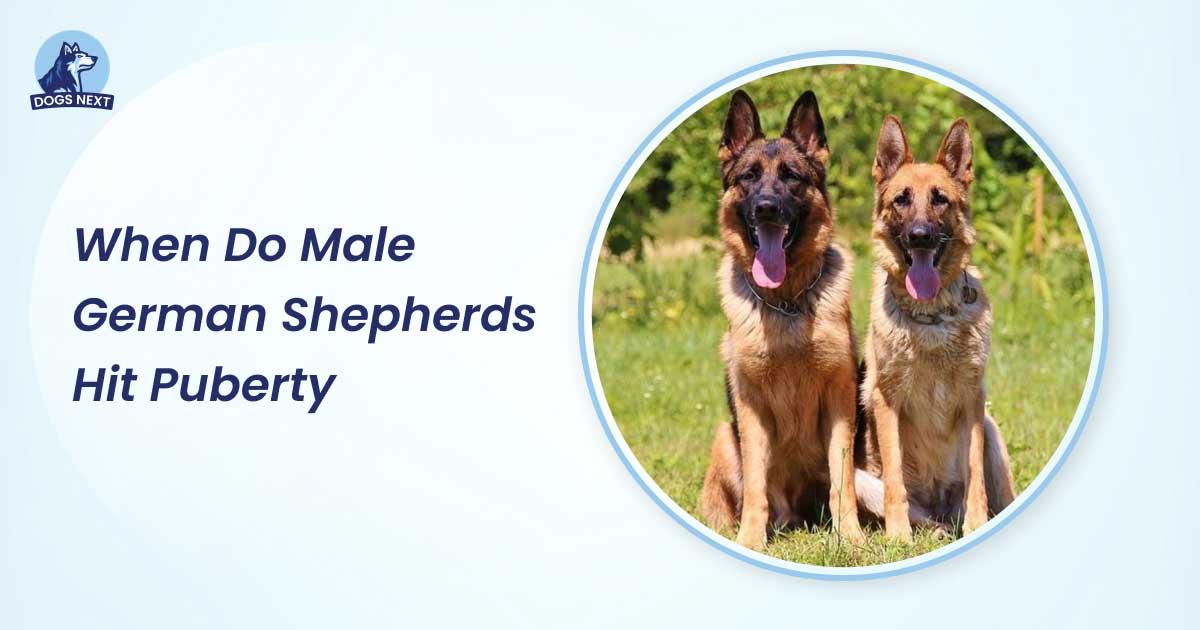Male German Shepherds typically hit puberty between 6 to 12 months of age. This period marks the beginning of their sexual maturity.
Male German Shepherds undergo significant physical and behavioral changes during puberty. This stage usually starts around 6 to 12 months of age. Owners may notice increased territorial behavior, marking, and a heightened interest in females. Consistent training and socialization are crucial during this time.
Proper nutrition and regular vet check-ups help manage their developmental needs. Understanding this phase can ensure a smoother transition to adulthood. German Shepherds are known for their loyalty, intelligence, and versatility. Recognizing the signs of puberty helps in addressing any behavioral issues early. This knowledge aids in maintaining their well-being and fostering a strong bond with your pet.
Age Range For Male German Shepherd Puberty
Male German Shepherds are fascinating and loyal companions. Understanding their growth stages helps in their care. One crucial stage is puberty. Knowing the age range for male German Shepherd puberty aids in anticipating their needs. This blog post will dive into the typical age for puberty and the physical changes to expect.
Typical Age For Puberty
Male German Shepherds usually hit puberty between six and twelve months of age. This period varies depending on genetics and individual growth rates.
Here’s a breakdown of the typical age range:
| Age Range (Months) | Developmental Stage |
|---|---|
| 6-8 | Early signs of puberty begin |
| 8-10 | Heightened hormonal changes |
| 10-12 | Full puberty |
Early signs of puberty might include:
- Restlessness
- Increased marking territory
- Behavioral changes
During heightened hormonal changes, you might notice:
- More pronounced physical growth
- Changes in fur texture
- Development of secondary sexual characteristics
Physical Changes
As male German Shepherds hit puberty, noticeable physical changes occur. Their bodies undergo significant transformations.
Key physical changes include:
- Increased muscle mass
- Broader chest and shoulders
- Growth in height and weight
The fur texture might change, becoming coarser. Secondary sexual characteristics develop, such as:
- Testes enlargement
- More pronounced scent marking
Behavioral changes often accompany physical ones. Expect:
- Increased aggression
- More pronounced territorial behavior
- Heightened interest in female dogs
Monitoring these changes helps in managing your dog’s growth effectively.
Behavioral Changes During Puberty
Male German Shepherds typically hit puberty between six and twelve months. During puberty, you will notice many behavioral changes. Understanding these changes is crucial for proper training and care. Let’s dive into the typical behaviors you might see.
Increase In Energy
During puberty, male German Shepherds experience a significant increase in energy levels. This sudden burst of energy can manifest in various ways:
- More Playfulness: Your pup may want to play more often and for longer periods.
- Restlessness: You might notice your dog pacing or unable to settle down.
- Increased Appetite: Along with energy, their appetite might also spike.
To manage this energy surge, ensure your dog gets adequate exercise. Daily walks, playtime, and mental stimulation are essential. Here’s a simple table to help you plan:
| Activity | Duration |
|---|---|
| Walk | 30-45 minutes |
| Playtime | 1 hour |
| Training | 15-20 minutes |
Aggressiveness
Another noticeable change during puberty is an increase in aggressiveness. This can be due to hormonal changes and a need to establish dominance. Common signs include:
- Growling: Your dog might growl more frequently, especially around other dogs.
- Snapping: Quick, aggressive bites or snaps can occur.
- Resource Guarding: Protecting toys, food, or other valued items more fiercely.
To manage these behaviors, use consistent training and positive reinforcement. Avoid punishment, as it can exacerbate aggression. Instead, reward calm and submissive behavior.
Marking Territory
Male German Shepherds will start marking their territory during puberty. This behavior is driven by a need to establish dominance and presence. Signs of marking include:
- Frequent Urination: Your dog may urinate in small amounts at various locations.
- Indoor Marking: Even if house-trained, indoor marking might occur.
- Marking Objects: Furniture, walls, and outdoor items could be marked.
To control marking, ensure your dog is neutered if you do not plan to breed. Consistent training and supervision are also key. Clean marked areas thoroughly to remove scents.
Common Behaviors
Puberty in male German Shepherds brings several common behaviors that might be new to you:
- Increased Mounting: Mounting other dogs, objects, or even people.
- Vocalization: More barking, whining, or howling than usual.
- Chewing: Excessive chewing on furniture, shoes, and other items.
These behaviors are normal and can be managed with proper training and attention. Here are some tips:
- Provide Chew Toys: Offer appropriate items for chewing to save your belongings.
- Training Commands: Teach commands like “quiet” or “off” for vocalization and mounting.
- Socialization: Regular interaction with other dogs can help reduce unwanted behaviors.
By understanding and managing these behaviors, you can help your male German Shepherd navigate puberty smoothly.
Training And Managing A Pubescent Male German Shepherd
Male German Shepherds usually hit puberty around six to eight months of age. This stage brings significant changes in their behavior and physical development. Training and managing a pubescent male German Shepherd can be challenging yet rewarding. Proper guidance during this phase ensures they grow into well-behaved and obedient adult dogs.
Obedience And Discipline
During puberty, consistent training is crucial for male German Shepherds. They need clear boundaries and structure to understand acceptable behavior. Daily training sessions help reinforce commands and keep them mentally stimulated.
Key commands to focus on include:
- Sit – Helps establish control in various situations.
- Stay – Essential for preventing unwanted behavior.
- Come – Ensures they return to you when called.
- Heel – Teaches them to walk calmly on a leash.
Positive reinforcement is the best method. Use treats, praise, and playtime as rewards. Avoid harsh punishments as they can lead to fear and aggression.
Consider enrolling them in an obedience class. Professional trainers can provide valuable insights and techniques. These classes also offer socialization opportunities with other dogs.
Here’s a simple training schedule:
| Time | Activity |
|---|---|
| Morning | 15 minutes of basic commands |
| Afternoon | 10 minutes of leash training |
| Evening | 15 minutes of advanced commands |
Behavioral Challenges
Pubescent male German Shepherds often exhibit behavioral challenges. Understanding these behaviors helps manage them effectively. Common challenges include:
- Increased Aggression – Hormonal changes can make them more territorial.
- Marking Territory – They may start marking with urine.
- Destructive Chewing – Chewing helps relieve discomfort from teething.
- Excessive Barking – They might bark more due to heightened alertness.
To manage aggression, socialize them with other dogs and people. This reduces fear and teaches them to behave calmly. Supervise interactions to ensure they stay positive.
For marking behavior, neuter your dog if not intended for breeding. Neutering reduces hormone levels and marking tendencies. Consistent house training also helps.
Provide plenty of chew toys to address destructive chewing. Chew toys keep them occupied and protect your belongings. Rotate toys to maintain their interest.
To reduce excessive barking, identify triggers and work on desensitization. Teach the ‘quiet’ command and reward them for staying calm. Exercise is vital for burning off excess energy and reducing barking.
Frequently Asked Questions
When Do Male German Shepherds Start Puberty?
Male German Shepherds typically start puberty between 6 to 9 months old. This can vary depending on the individual dog.
What Are Signs Of Puberty In Male German Shepherds?
Signs include increased marking behavior, interest in females, and physical changes like testicle development. Behavioral changes can also occur.
How Long Does Puberty Last In Male German Shepherds?
Puberty in male German Shepherds lasts for several months. Full maturity is generally reached around 2 to 3 years of age.
Do Male German Shepherds Become Aggressive During Puberty?
Some male German Shepherds may show increased aggression during puberty. This is due to hormonal changes.
Conclusion
Understanding when male German Shepherds hit puberty helps in their proper care. Typically, they reach puberty around 6 to 12 months. Monitoring their behavior and health during this phase is crucial. By being attentive, you ensure a smooth transition into adulthood.
Stay informed to provide the best care for your furry friend.

I’m David, an expert contributor and writer, with two furry friends of my own, I know the challenges of raising and caring for dogs. From training to nutrition and health, my goal is to provide valuable insights and advice to help create strong bonds and happy, healthy lives. Find me in Twitter.




